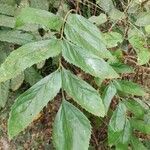Shrub or tree 1-8(-15) m tall; young branches light brown, short-appressed-pilose, rapidly glabrescent; bark usually light brown when young, dark grey, dark purple to red-grey or red-brown after peeling of outer layer; lenticels numerous, usually inconspicuous. Leaves simple in mature plants, rarely compound, blade chartaceous to very rigid-coriaceous, drying pale grey green, glaucous to mid brown, sparsely pilose, glabrescent, hairs often persistent along lower midvein and below Simple leaf: petiole 1-6 cm long x 1-2 mm broad at midlength, sometimes canaliculate, sparsely to densely ferrugineous-to grey-velutinous or appressed-tomentose to pilose, glabrescent; blade extremely variable, from narrowly ovate to widely ovate, elliptic to widely elliptic, oblong, and more rarely suborbiculate, 4-14 x 2-9 cm (length:breadth 1.2-3:1), base acute, obtuse, rounded, sharply decurrent, apex acute or obtuse and narrow-attenuate, or rounded, margin revolute or not, entire, undulate, or serrate with 3-22 pairs of teeth; venation obscure to conspicuous, slightly impressed, plane, or slightly raised above, usually conspicuous and prominent below, semicamptodromous, midvein reaching apex, secondary veins 4-9 pairs, marginal vein thick and prominent below, single or double fractiflexed. Compound leaves: 19.7-33 cm long (including 4.5-11.4 cm long petiole); leaflets 4-8 pairs; petiolules lateral leaflets 0-5 mm long, blade lateral leaflets 6.2-12.2 x 1.2-4.3 cm (length:breadth 1.9-6.5:1), base strongly to weakly asymmetrical, cuneate to angustate, acute to rounded, apex acute to attenuate, margin serrate with 3-20 teeth, rarely entire; secondary veins 3-6 pairs; petiolule terminal leaflet 2-2.3(-4) cm long, blade 7.6-11.1 x 2.7-7.6 cm (length:breadth 1.3-3.7:1), base symmetrical to asymmetrical, attenuate, sometimes rounded to almost truncate, apex acute to attenuate, margin serrate with 7-9 pairs of teeth, secondary veins ca. 3 pairs Inflorescence axillary, occasionally terminal, unbranched, 5-20 cm x 1.7-2.8 mm, indument light brown, brown, short, sparsely; peduncle 0.5-3 cm x 0.8-2.5 mm; sterile bracts few to abundant towards base; common bracts 0.4-1.3 x 0.3-2.5 mm, margin fimbriate, to densely short tomentose outside, glabrous within; flower-pair axis absent; pedicels 1.5-4.5 x 0.3-1 mm. Flower buds 0.8-1.7 mm broad at apex, 0.5-1 mm broad at midlength, square to rounded in section. Flowers 7-9 mm long, glabrous, to very sparsely shortly-appressed-pilose, to densely pilose; filaments 0-0.8 mm long, attached to tepals 2-6.5 mm from base, anthers 1.5-3 x 0.4-0.8 mm; hypogynous glands 0.2-0.6 mm long, fleshy, lobes free; ovary symmetrical or asymmetrical, more curved on one side than on the other (like half a pair), hairs extending to 1-3 mm from base, covering entire ovary or lower on one side, short-sericeous, hairs light brown, orange, ferrugineous to rufous. Infructescence 5-19 cm long, glabrous to puberulent or sparsely tomentose; fruit pedicels 2-5 x 0.8-1.5 mm. Fruit 2-3.5 x 0.8-1.5 cm, both sutured and unsutured sides curved equally or sutured side curved more strongly, base constricted for 3-6 mm, apex not constricted or constricted to 4 mm, including persistent style base, straight or curved until perpendicular to unsutured side, marginal vein inconspicuous to conspicuous, venation sometimes conspicuous on suface, light brown to dark brown, apressed pilose, or densely velutinous when young, hairs light brown to orange-brown to rufous, glabrescent, glabrous at maturity; seeds 1.8-2.5 x 0.5-1 mm.
More
Trees to 20 m. tall, the young stems terete, ferrugineous-strigillose and glabres-cent. Leaves heteromorphic; juvenile leaves pinnately compound, generally larger than the adult forms, the number of leaflets extremely variable even on a single branchlet, margin generally coarsely serrate or sometimes undulate, the veins con-spicuous; adult leaves ovate, 5-12 cm. long, 2-9 cm. broad, acute or acuminate at the apex, cuneate to more or less obtuse at the base and often decurrent upon the petiole, subcoriaceous or coriaceous, ferrugineous-strigillose and glabrescent above and below, the costa plane to immersed above, emersed below, the primary lateral veins numerous, conspicuous, the margin entire, undulate to variously dentate or serrate, often repand; petiole 1-6 cm. long. Inflorescence racemose, terminal or more often axillary, multi-flowered, the rhachis 6-15 (-18) cm. long, tomentose, the flowers borne singly or in pairs. Tepals linear-oblanceolate, 7.0-8.5 mm. long, about 1 mm. broad, widely reflexed, strigillose without, glabrous within; stamens inserted about at the middle of the perianth, the anthers linear-oblong, 2-3 mm. long, 0.5 mm. broad, the filaments about 0.5 mm. long, glabrous; hypogynous glands about 0.5 mm. tall, carnose, glabrous; ovary about 1 mm. long, 1 mm. in diameter, densely strigose, the style about 3 mm. long, glabrous, the stigma narrowly clavate; pedicel to 3 mm. long, strigillose. Fruit a flattened follicle, often minutely spurred at the base, 2.5-4.0 cm. long, about 1.5 cm. broad, glabrous, the winged seeds oval, 1.5 cm. long, 0.8 cm. broad.


